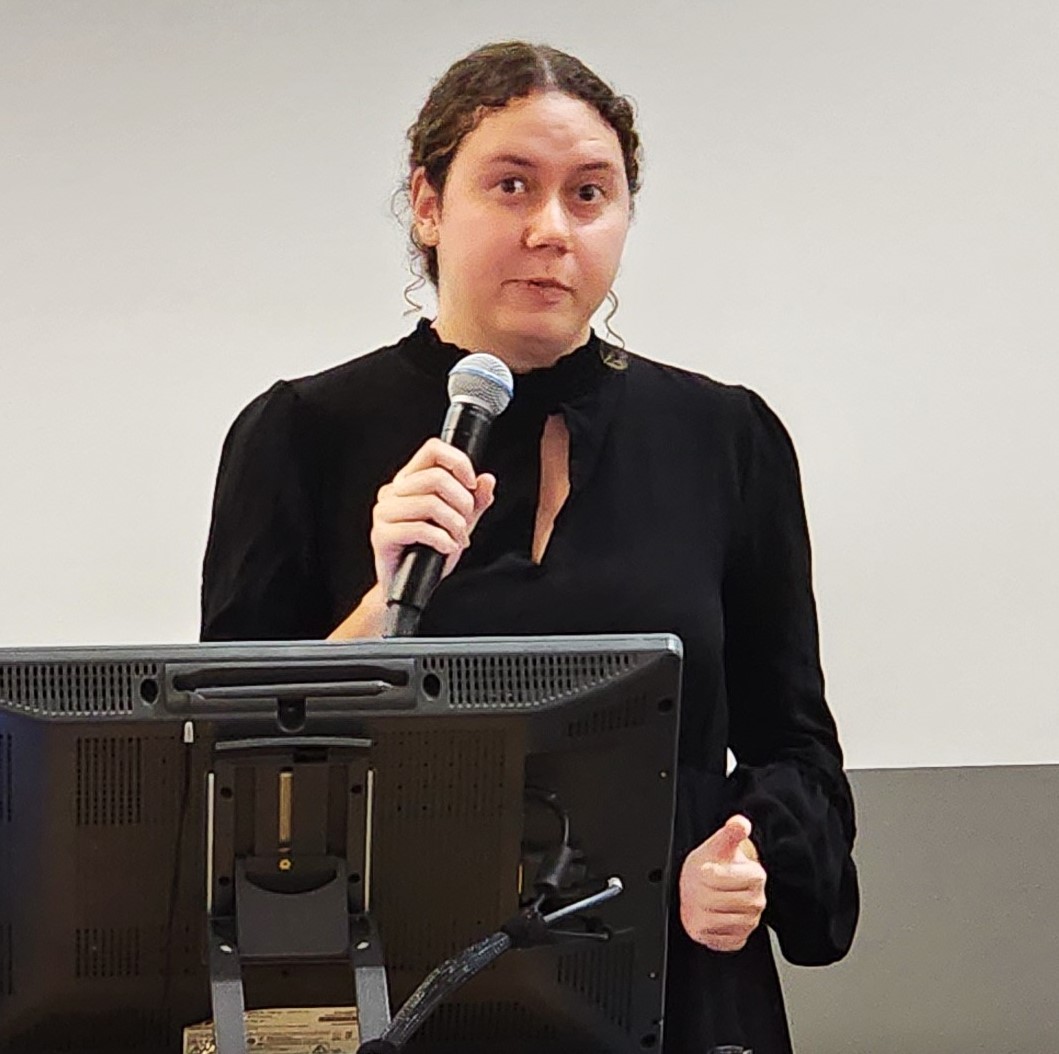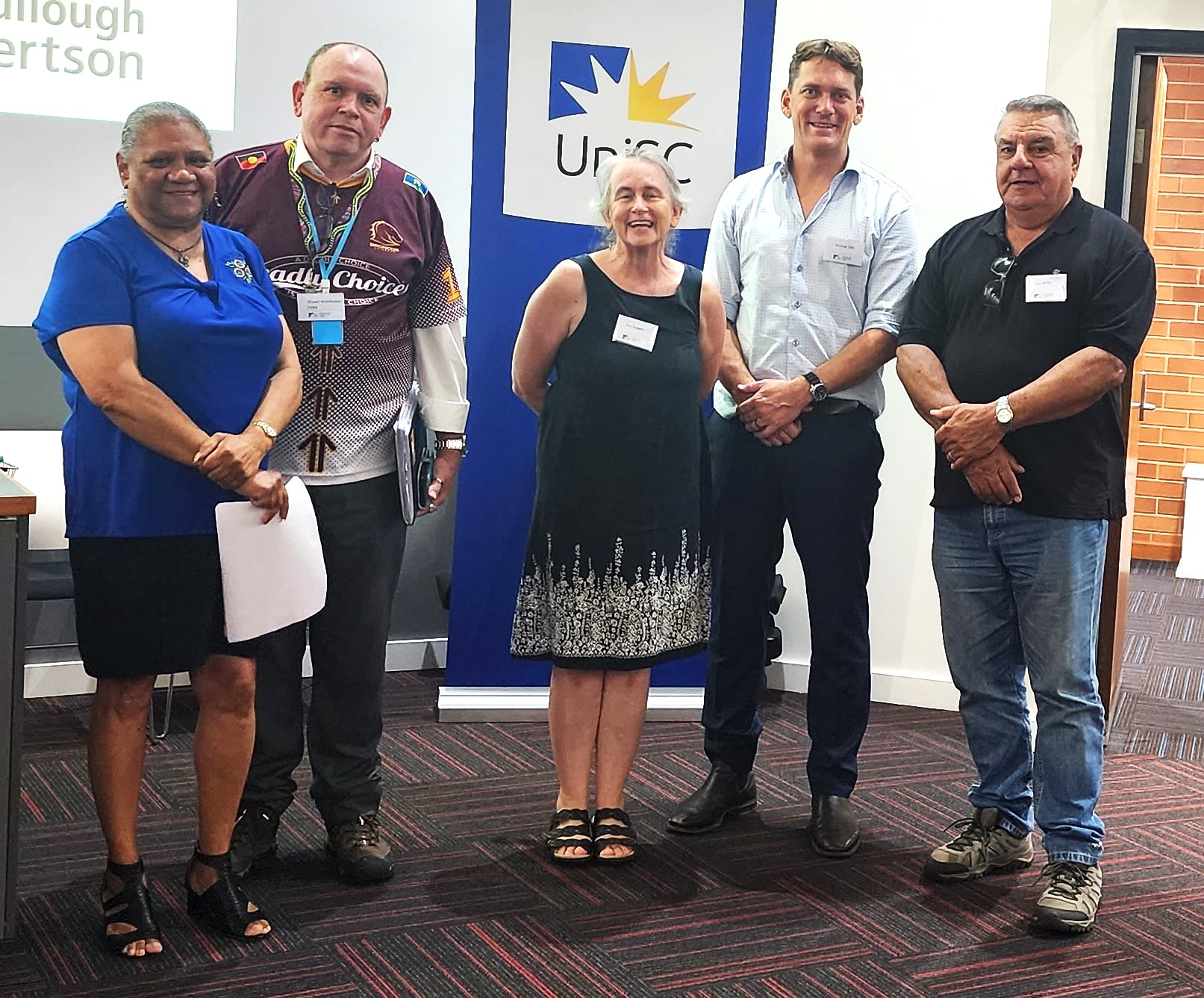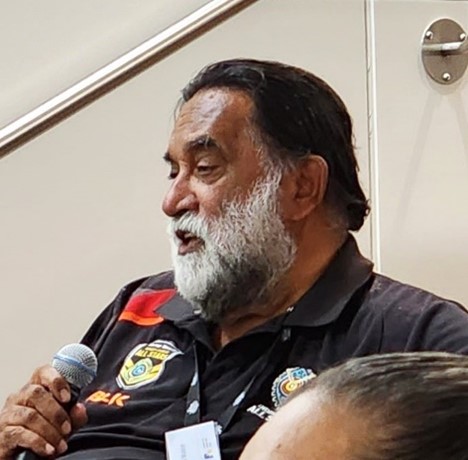- Shania Clarke was the first speaker at the conference in Day 2
- Day 1 morning presenters Veronica Bird, Shawn Foley, Chair Sue Sargent, Andrew Olds, Glen Miller
- Jade Gould
- Les Malezer asks a question from the floor
On November 9 and 10, FIDO members attended the K’gari conference at the Fraser Coast campus of the University of the Sunshine Coast. At this two-day event, our own Peter Shooter presented a session on the Pandanus restoration programme that FIDO has been running with Isaac Neisler and his team.
The conference hosted a number of renowned presenters, so Peter was in a very distinguished company. We heard from Professor Ian McNiven and Christine Royan about the new co-designed ARC Centre of Excellence for Indigenous and Environmental Histories and Futures. The BAC is 1 of 8 formal Indigenous Partner Organisations in the Centre, along with seven universities and a range of museums and other government agencies. Called a Discovery grant, it is aimed at helping develop research methods which respect Indigenous perspectives and values. The Butchulla Aboriginal Corporation (BAC) is partnering with a team of distinguished academics in this programme, which aims to support 70 Indigenous students in gaining a doctorate.
Conference organiser Dr Kim Walker from UniSC involved a broad selection of Butchulla presenters and speakers. Auntie Veronica Bird from the Butchulla Native Title Aboriginal Corporation (BNTAC) gave a very eloquent welcoming speech. Professor Alex Elibank Murray, Head of the Fraser Coast UniSC campus, also welcomed us. Other dignitaries present were Adrian Tantari, the member for Wide Bay and George Seymour, Mayor of the Fraser Coast Regional Council. They both displayed a genuine interest in the progress of the conference and its outcomes.
A very popular presentation on the morning of Day #1 was from Butchulla elder Uncle Glen Miller. Glen’s presentation included his personal memories of Korrawinga (the Butchulla name for the Sandy Strait). Glen works with Butchulla men and boys on a large property near Poona, which includes the coastal sites where Butchulla people traditionally crossed from the islands to the mainland during their seasonal movements around their very large estate. He noted increased growth of mangroves and expressed concerns about decreasing amounts of seagrass growing in Korrawinga. On Day 1, we also heard from Professor Andrew Olds, who comes from a Maryborough family and spent a lot of youthful holidays on K’gari. He presented a synthesis of some of the marine research done on Butchulla Sea Country. Andrew was interested in working with Uncle Glen Miller in collecting baseline data about the benthic sediments in Korrawinga. This is just one of the productive networking connections made during the event.
Auntie Veronica Bird, general manager of BNTAC and Shawn Foley spoke about the sea turtle rescue and research centre, which is being set up at Urangan. Auntie Veronica and Shawn elaborated on the project, implementing the three primary Butchulla lores/laws.
Rule #1 – What is good for the land must come first.
For the Butchulla people, the land is not just a place to live; it is a living entity with its own seasons, rhythms and natural life cycles. We believe the well-being of Country (land, sea and sky] is of supreme importance as it sustains us physically, culturally and spiritually. Our actions must prioritise its health, wellness and vitality. By nurturing and protecting country, we ensure a harmonious existence for all living creatures and maintain a deep connection to our people, place and home.
Rule #2 – Do not touch or take anything that does not belong to you.
Aunty Veronica elaborated on this rule by saying that respect and reciprocity are fundamental principles in Butchulla lore. “We understand that every element of Country (land, sea and sky] from the tiniest grain of sand to the tallest tree has its place and purpose. Our lore guides us to take only what we need and to do so respectfully, seeking permission and acknowledging the custodianship of others.”
Rule #3 – If you have plenty, you must share
We believe that abundance is to be shared, not hoarded. Whether it’s food, resources or knowledge, our law teaches us that our way forward must not be ego-focused but spirit-centred, which means actively extending helping hands to those in need.
This session was chaired by Sue Sargent, the current chairperson of FINIA, an organisation dedicated to maintaining the natural integrity of K’gari and the World Heritage Advisory Panel.
After lunch, there were presentations by students from the University of the Sunshine Coast (UniSC). Hannah Maloney has been collaborating with BNTAC and Australia Zoo to explore the waters of K’gari, looking for potential important aggregation sites for manta rays. Caitlin Smith has been working on Sea turtle health assessments and ecotoxicology. Dedicated volunteers Don and Lesley Bradley presented reports on their work with turtles and shore birds.
Next came time for the participants to join together in in groups to discuss issues. With large sheets of butcher’s paper and felt pens, we recorded group discussions: One topic was the newly released Marine Park zoning plan. Another was the issue of the loss of seagrass in Korrawinga. The main concern here was to reduce sediment during flood events, which coats the seagrass and prevents it from photosynthesising. The sheets from each table were collected and collated by the organisers.
Day 2 began with a presentation by Shania Clark, a Butchulla woman who attended a cultural and language programme run by Auntie Joyce Bonner during her childhood. Shania, her sisters and other young Butchulla girls attended, learning Butchulla language, dancing, weaving and other handcrafts. She regards it as an excellent preparation for her adult life and paid tribute to Aunty Joyce’s work.
Jade Gould, who has completed a science degree and worked in natural resource management, spoke on bringing Western scientific knowledge together with traditional Butchulla knowledge.
Dr Annie Ross, from the University of Queensland, gave a talk based on her research with similar islands to K’gari further South, including those that we call Stradbroke Island, Morton Island and Bribie Island. She presented an excellent summary of seasonal triggers which were used as a calendar in traditional times, including the flowering of particular plants, which would indicate that mullet were moving out of the rivers; when hairy caterpillars emerged, this was associated with the mullet migrating to sea to spawn; increased numbers of lorikeets was seen as an indicator of abundance of the mullet and when the sea eagle flew high the mullet were coming up the coast and people would make preparations for fishing. An interesting angle on this was that in the area where Annie did her research, the traditional owners had a reciprocal relationship with dolphins. As the mullet moved into the Bay, they would begin their ritual call to the dolphins, which helped herd the fish for easy catching. Annie’s presentation was accompanied by interesting maps and diagrams and created a great deal of interest. A distinguished guest at the symposium was Mr Les Malezer, a Butchulla man who has had a distinguished career in public service and as a representative to the United Nations. He has been involved since its inception with FAIRA, a trail-blazing Indigenous research organisation.
The next event on the programme was a presentation by Butchulla Rangers. We heard from John Green and Bob Broome. Bob has previously worked with FIDO teams on weeding programmes, and is now the head of a newly recruited group called the RAM Rangers. This team has been designed to advance the BAC’s vision of greater influence in preserving K’gari, and their work includes visitor engagement and compliance, focusing on permit cheques, cultural compliance, education and visitor surveys at popular locations like Eli Creek, Boorangoora, Indian Head (Takky Woroo) and popular camping sites. They aim to record, map and monitor sites across the island to better manage and preserve their cultural significance to the Butchulla people.
A researcher who has contributed a great deal to understanding of the sand dune formations on K’gari is Professor Jamie Schulmeister. Jamie has presented at K’gari conferences before and is currently working in New Zealand at the University of Canterbury but returned for the conference to deliver an interesting presentation about the sequence of sand dunes on K’gari, noting the vegetative progression from marram grass to rainforest and satinay and, in some areas, back to wallum.
Professor Kathy Yule is a UniSC researcher who’s been doing some work based in Dili village. Her work deals with the patterned fens and the underlying peatlands, and she provided some interesting explanations of how Empodisma minus (the wire rush) covers many acres of land in the fens in one complex superorganism. As the roots go down they form peat layers many metres thick. Surprisingly, the acidic and low-nutrient waters of the pattern fence support quite an array of creatures, including acid-tolerant sedge frogs and the elusive ground parrot.
Another presenter from UniSC was Gabriel Conroy. He asked some vital questions concerning fire regimes: What are we burning for? Do we wish to preserve the ecosystem’s identity? Are we trying to conserve threatened species? Is it for cultural values or to safeguard human habitations and infrastructure? He discussed the patch and mosaic burning programmes traditionally used by Butchulla caretakers and noted that these types of firing regimes seemed to preserve biodiversity most successfully.
We also heard from Dr Linda Behrendorf, who has earned a PhD from the University of Queensland for her research into wongari or dingoes. Unfortunately, we didn’t hear much about that research, but we hope to at a future date. She tells us that a book is forthcoming. Linda spoke mainly about the challenges of managing visitors on K’gari. She examined the reasons why people come to K’gari. These include sightseeing, fishing, bird watching, photography, water-based activities and, increasingly, cultural experience. The Butchulla people have recently set up the Butchulla Enterprises Limited (BEL), which will hopefully provide some income for people and increase visitors’ appreciation of K’gari’s cultural heritage.
Another group workshopping session followed the day’s presentations on day 2, and on this occasion, participants investigated issues such as visitor impacts on sensitive areas, alternative transport options, and visitor education for safety. The huge question of attracting younger people’s interest in caring for K’gari generated lively debate.
On the whole, the experience of two days’ intensive immersion in the issues confronting K’gari while in the company of a large number of people produced a feeling of intense cultural immersion. The round table sessions allowed people to discuss things and have a say. The presenters also took part in these roundtables, so people were able to ask more questions than they could in the big group. Every piece of butcher’s paper was covered in notes and arrows and different coloured words and underlined and circled sentences, so it seems that quite a lot of information will come out in due course when they’re all collated. From FIDO’s point of view, it was really impressive to see Lyndall, Valerie, and JT from the short trip group based in Maryborough there. We met FIDO member Charlene face-to-face for the first time. Charlene has been involved with beach cleanups through her four-wheel drive club and has done other work on the island. I am really thankful to have had the chance to share time with these far-flung members of FIDO. Hopefully, many of the connections and partnerships initiated during the event will bear fruit in years to come.




